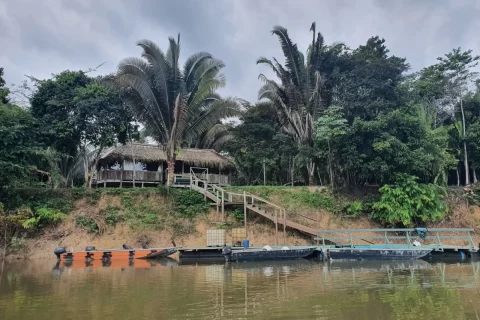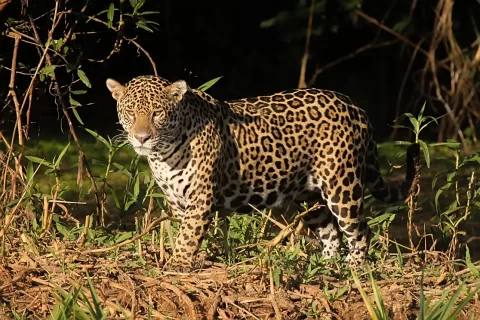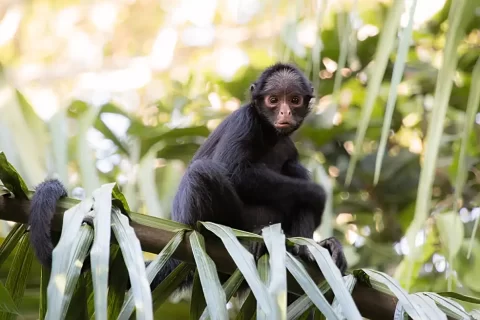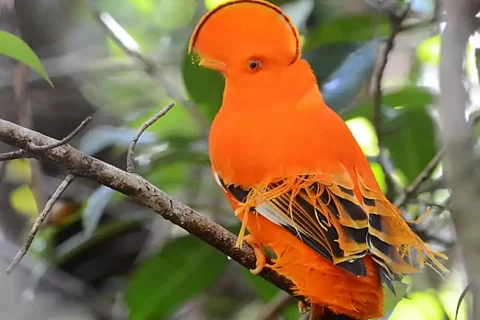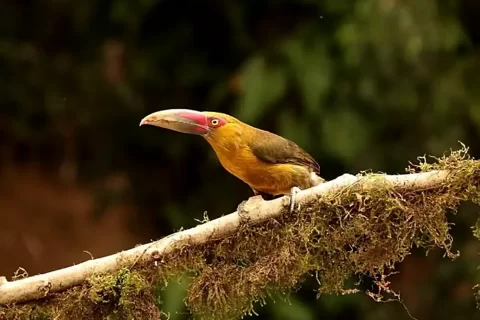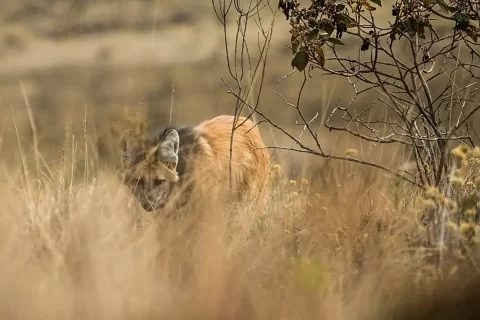Best time of year:
May – November
Duration:
15 days
Difficulty:
Easy terrain. Challenging birding.
Accommodations:
Mostly good. One simple hotel in Tabajara, otherwise mostly city hotels.
Starts in:
Porto Velho
Ends in:
Rio Branco or Porto Velho
Tour Overview
There is no doubt that the Amazon rainforest is the most likely area on the planet to hold new discoveries for science, proof of which came in 2013 when no fewer than 15 new bird species were described in a special edition of the Handbook of the Birds of the World. A number of those discoveries came from the extremely poorly known region of the Aripuanã river of the Southern Amazon in Brazil lying between the Madeira and Tapajós rivers. Further research in this region indicates that more discoveries are yet to be made, and bird surveys in key areas have revealed an impressive biodiversity. So naturally we decided to start offering tours to the region! Our tour to the region is headlined by the Rondonia Bushbird, a species so rare only a handful of birders have ever seen it since it was first described to science in 1986 — a mega in every sense of the word. We also target more than a half dozen other newly described species to science in addition to a strong supporting cast of regional endemics and near-endemics. This trip to the remote reaches of the southern Amazon in the vicinity of the Campos Amazônicos National Park, the Mapinguari National Park, and the bamboo-laden forests of eastern Acre offers an opportunity to see some of the least known birds of the Amazon. It is an antbird enthusiast’s dream trip, with chances for Rondonia Bushbird, Black-bellied Gnateater, White-breasted Antbird, Undulated Antshrike, Ferruginous-backed Antbird, Alta Floresta Antpitta, Banded Antbird and five newly described antbirds. Add in Blue-headed Macaw, Rufous-headed Woodpecker, Black-faced Cotinga, Bonaparte’s Parakeet, Campina Jay, Chico’s Tyrannulet, Rufous Twistwing, Acre Tody-Tyrant, White-browed Hawk, Cryptic Forest-Falcon, Buff-cheeked Tody-Flycatcher, Snow-capped Manakin, and Orange-fronted Plushcrown, and one has the makings of some of the most exciting forest birding on the planet.
Itinerary
Day 1: Arrival in Porto Velho.
Arrival in Porto Velho. You will be met at the airport for the transfer to a comfortable hotel with all modern conveniences in Porto Velho, the capital of the state of Rondônia. Depending on arrival schedules, there may be time for a bit of birding in the afternoon near Porto Velho.
Night in Porto Velho.
Day 2: Birding on west bank of the Madeira river.
During this first morning we bird tall forests and sandy belt campinarana on the west bank of the Madeira river. The Madeira is a major barrier to speciation of Amazonian forest birds, and our principal focus today will be on west bank birds. First and foremost among these are a quartet of recently described species: Campina Jay, Western Striolated Puffbird, Inambari Woodcreeper, and Predicted Antwren. Other interesting birds found at this site include Brown-mandibled Aracari, Peruvian Warbling-Antbird, Humaitá Antbird, Citron-bellied Attila, and an as-yet-undescribed species of Hemitriccus tody-tyrant. After lunch in Porto Velho we drive east for approximately five hours to the small village of Tabajara in north-central Rondônia.
Night in Tabajara.
Days 3 – 5: Birding Tabajara area.
We have three full days to work the extremely diverse Tabajara area on the fringes of the Campos Amazônicos National Park. Avian surveys undertaken in this region have produced a bird list in excess of 500 species, including 51 species of typical antbirds! The highlights are numerous, and there is an excellent variety of trails and habitats in the immediate vicinity of the small village of Tabajara, easily enough to keep us busy during our stay here. We will bird open sandy campinas near the village to look for the recently described Chico’s Tyrannulet and other white sand specialists such as Rufous-crowned Elaenia, Pale-bellied Mourner, Green-tailed Goldenthroat, and Campina Thrush. In the taller campinarana forest nearby, a long trail takes us into great habitat for such rare specialties as Buff-cheeked Tody-Flycatcher, Black Manakin, Zimmer’s Tody-Tyrant, and White-breasted Antbird. Other more widespread, but equally compelling birds here include Spotted Puffbird, Bronzy Jacamar, Snow-capped Manakin, and Rondonia Warbling-Antbird. A visit to the Marmelo stream upriver on the Rio Machado from Tabajara will target Manicoré Warbling-Antbird, Aripuanã Antwren, Roosevelt Stipple-throated Antwren, and Black-bellied Gnateater. Closer to Tabajara we are certain to spend time on the excellent Caldeirão track to look for Pearly Antshrike, Uniform Woodcreeper, Pavonine Quetzal, Cinnamon-crested Spadebill and more. We’ll be on the alert for any sign of an active army ant swarm, as two of the biggest targets of the tour are a duo of fancy, endemic antbirds: the White-breasted Antbird, and the rare Pale-faced Bare-eye, both of which are obligate army ant followers.
Nights in Tabajara.
Day 6: Return to Porto Velho and birding on W bank of the Madeira.
We return to Porto Velho in the morning, arriving in time for lunch in the city. En route we will stop at a roadside service station where Rondonia (Versicolored) Emerald often visits overgrown flower beds. In the afternoon we bird on the west bank of the Rio Madeira to look for Campina Jay, Bluish-fronted Jacamar, Humaitá Antbird, and Predicted Antwren.
Night in Porto Velho.
Day 7: Savannas between Porto Velho and Humaitá.
An early start this morning sees us driving before dawn to an area of native grasslands ca. 100 km from Porto Velho. These enclaves of cerrado-like grasslands are distributed patchily in the southern Amazon, and they host a very different avifauna from what we will have encountered thus far on the trip. Our major target here is the elusive Ocellated Crake, which is always difficult to see but is rather abundant here, meaning we should have plenty of crakes to work on during the first couple of hours of the day. Other grassland birds to expect this morning include Black-masked Finch, Plumbeous and Dark-throated Seedeaters, Cinereous-breasted Spinetail, Peach-fronted Parakeet, White-eared Puffbird, and Sharp-tailed Tyrant. In the afternoon we drive to the town of Humaitá, where we stay three nights.
Night in Humaitá.
Day 8: Humaitá varzeas and terra firme.
We have a full day and a full morning to bird around Humaitá, a pleasant town situated on the west bank of the Madeira river. A morning visit to seasonally flooded varzeas on the east bank of the Madeira is always very birdy, and just from along the edges of the Transamazonica highway we can find Horned Screamer, Slate-coloured Hawk, Festive Parrot, Chestnut-capped Puffbird, Zimmer’s Woodcreeper, Leaden Antwren, the obidensis subspecies of Plain Softtail, Masked Crimson-Tanager and much more. The balance of our time around Humaitá will be spent birding in terra firme forests in search of Inambari specialties such as Inambari Woodcreeper, Madeira Stipple-throated Antwren, Fulvous-chinned Nunlet, and Inambari Gnatcatcher, along with the likes of Bar-bellied Woodcreeper, Black Bushbird, Golden-collared Toucanet, Blue-crowned Manakin and Dotted Tanager.
Night in Humaitá.
Day 9: Travel to Jaci-Paraná.
A full morning’s birding near Humaitá before we drive back to Porto Velho and continue to the south-west to the town of Jaci-Paraná, where we stay two nights.
Night in Jaci-Paraná.
Day 10: Rondonia Bushbird day.
Today we search for Rondonia Bushbird in a well-preserved piece of forest up the Jaci river. While the Bushbird is undoubtedly our main target here – and we will spend the bulk of our time today patiently working the bird’s highly specialized habitat niche – there is no shortage of high quality Amazonian birds to see here: Madeira Parakeet, Rondonia Warbling-Antbird, Tapajos Antpitta, Dusky-capped and Hoffmanns’ Woodcreepers, White-breasted Antbird, Black-necked Red-Cotinga, and Tooth-billed Wren are amongst the birds we’ll be looking for. Night in Jaci-Paraná.
Day 11: River islands in the Madeira. Travel to Acre.
Morning birding on river islands near Jaci-Paraná where island specialties such as Orinoco Goose, Black-and-white Antbird, Parker’s Spinetail, White-bellied Spinetail, Brownish Elaenia, Lesser Wagtail-Tyrant and Riverside Tyrant occur. We spend the rest of the day driving from Jaci-Paraná to Rio Branco, the capital city of Acre state (ca. 7 hours drive).
Night in Rio Branco.
Day 12 – 14: Rio Branco area.
We have three full days to bird in the bamboo-rich forests of eastern Acre, areas which are unfortunately disappearing quickly as cattle ranching and agriculture continue to encroach upon once-spectacular areas of rainforest. Our principal targets are a suite of birds which are shared between extreme South-west Amazonian Brazil, South-east Peru, and remote Northern Bolivia. Included amongst this group are such spectacular species as Blue-headed Macaw, Rufous-headed Woodpecker, White-throated Jacamar and Black-faced Cotinga. In the Amazon, bamboo of course means antbirds and flycatchers, and we have no shortage of those to look for: Bamboo Antshrike, Bluish-slate Antshrike, Goeldi’s Antbird, Ornate Stipplethroat, Bamboo (Ihering’s) Antwren, Yellow-breasted Warbling-Antbird, Striated, Riparian and Manu Antbird are amongst the antbird possibilities, while specialty flycatchers here include Rufous Twistwing, Long-crested Pygmy-Tyrant, Acre Tody-Tyrant, Flammulated Bamboo-Tyrant, and White-cheeked Tody-Flycatcher. Other specialties in the bamboo forests and associated habitats include Rufous-breasted and Fine-barred Piculets, Yellow-billed Nunbird, Lemon-throated Barbet, Southern Emerald Toucanet, Black-capped Parakeet, Peruvian Recurvebill, Sulphur-bellied Tyrant-Manakin, White-rumped Sirystes, and Black-and-white Tanager. Areas of varzea forest host Johannes’s Tody-Tyrant and Plumbeous Antbird, while Rufous-fronted Antthrush is a very rare possibility; a site farther afield might be worth a visit for Purus Jacamar and Black-banded Crake. During our time in Acre we will be based in a comfortable hotel in Rio Branco.
Nights in Rio Branco.
Day 15: Departure. Departure from Rio Branco.
Chandless State Park Extension
Our Southern Amazon Megas itinerary can be combined with an extension to Chandless State Park in the remote upper Purus river basin in the borderlands between Brazil and Peru. Chandless is reached by a long trip overland (3 hours drive) and by river (8 hours upriver, depending on the season). The park has very basic accommodations in dormitories. A grid of research transects comprises part of a good trail system providing access to fantastic terra firme forest, bamboo forest, and interesting várzeas and oxbows. A range of southwest Amazonian specialties of deep forest occur here, including Bartlett’s Tinamou, Pale-winged Trumpeter, Chesnut-headed Crake, Western Striolated Puffbird, Semicollared Puffbird, Fulvous-chinned Nunlet, Rufous-headed Woodpecker, Amazonian Parrotlet, Blue-headed Macaw, Bamboo Antshrike, Undulated Antshrike, Purus Antwren, Hairy-crested Antbird, Banded Antbird, Ash-throated Gnateater, Elusive Antpitta, Rusty-belted Tapaculo, Striated Antthrush, Gray-throated Leaftosser, Ocellated Woodcreeper, Dusky-cheeked Foliage-gleaner, Ruddy Foliage-gleaner, Sulphur-bellied Tyrant-Manakin, Plum-throated Cotinga, Black-faced Cotinga, Long-crested Pygmy-Tyrant, Dusky-tailed Flatbill, White-rumped Sirystes, Yellow-crested Tanager, and Yellow-shouldered Grosbeak. Open areas around the park headquarters have Black-banded Crake, Golden-tailed Sapphire, Purus Jacamar, Violaceous Jay and Lesson’s Seedeater. Oxbows upriver from the park headquarters are home to Scarlet-hooded and Lemon-throated Barbet, Plumbeous Antbird, and Casqued and Band-tailed Caciques.
Day 1: Travel from Rio Branco to Manoel Urbano, birding Antimary Reserve en route.
Overnight in Manoel Urbano.
Day 2: Travel to Chandless State Park.
Overnight in Chandless State Park.
Day 3 – 6: Chandless State Park.
Overnight in Chandless State Park.
Day 7: Return to Rio Branco.
Overnight in Rio Branco, or late night departure (most flights depart Rio Branco quite late).
Accommodations: We stay in a simple hotel in Manoel Urbano. The park headquarters at Chandless State Park have basic dormitory-style accommodations with shared facilities.
Difficulty: The birding at Chandless is mostly deep in forest, with shy birds in the dark understorey. The trails have some difficult sections with steep climbs. This extension is expedition-style birding and is not for everyone.









